List of grand masters of the Constantinian Order of Saint George

This is a list of grand masters of the Constantinian Order of Saint George, a dynastic order of knighthood of the Catholic Church. Although it was founded by Albanian nobles claiming descent from the Byzantine Angelos dynasty in the 16th century, the order has throughout its existence maintained that it has its origin in Ancient Roman times, supposedly founded by Constantine the Great in the 4th century.[1] Such an origin is otherwise regarded as being impossible, as there are no Roman or Byzantine records of such an institution ever existing and chivalric orders being completely unknown in the Byzantine world.[2][3]
The founders of the order, the Angeli family, provided forged genealogies tracing their descent back to the 4th century, with grand masters covering the period from the Constantinian dynasty to the 16th century. These grand masters, maintained in modern official lists of grand masters, are mostly entirely invented, though some were real historical figures albeit with no connection to the chivalric order.[4] In 1698, the position of grand master passed to the House of Farnese, and in 1732 it passed to the House of Bourbon-Two Sicilies, once rulers of the Kingdom of the Two Sicilies, to which the office still belongs. The line of grand masters within the House of Bourbon is divided today, with three separate claimants to the position. The Parmese branch of the Constantinian order split from the legitimate order in 1816 and is still maintained by the House of Bourbon-Parma. The legitimate order has itself been the subject of a succession dispute since 1960, which has in effect produced separate Spanish and Neapolitan orders, though neither recognizes the other as legitimate.
In addition to these succession disputes, claims to be the legitimate grand master of the Constantinian Order have also been forwarded by many impostors and pretenders to Byzantine titles and descent, on account of the order's invented Byzantine origins and its form of hereditary succession. As such, forgers who have claimed to represent "rightful" Byzantine emperors or dynasts have also often claimed the position of grand master. Several such "grand masters" remain active today.
Legendary grand masters (313–1570)[]
The founding family of the Constantinian Order, the Angeli, made great genealogies that traced their descent back to the 4th century, as supposed descendants of Constantine the Great, with grand masters covering this period up untli the 16th century. These grand masters are maintained in modern official lists of grand masters, but they are almost entirely invented figures. A handful of individuals are genuine historical figures, but they have no connection to the later chivalric order.[5]
- Constantine the Great, Roman emperor 306–337, allegedly founded the order in 313
- Constantine II Flavius, Roman emperor 337–340
- Constans I Flavius, Roman emperor 337–350
- Constantius II Flavius, Roman emperor 337–361
- Constans Gallus Angelos Flavius, "Prince of Macedonia", grand master 361–362
- Michael I Gallus Angelos Flavius, "Prince of Macedonia", grand master 362–428
- Alexios I Angelos Flavius Comnenos, "Prince of Macedonia", grand master 428–458
- Alexios II Angelos Flavius Comnenos, "Prince of Cilicia and Macedonia", grand master 458–514
- Michael II Angelos Flavius Comnenos, "Prince of Cilicia and Macedonia", grand master 514–548
- Alexios Michael Angelos Flavius Comnenos, "Prince of Cilicia and Macedonia", grand master 548–586
- Angelo Michael III Angelos Flavius Comnenos, "Prince of Cilicia and Macedonia", grand master 586–617
- Philipp Basilius Pippin Angelos Flavius Comnenos, "Duke of Drivasto and Durazzo, Despot of the Pelopponesus", grand master 617–625
- Isaac I Angelos Flavius Comnenos, "Prince of Cilicia and Macedonia", grand master 625–667
- Alexios III Angelos Flavius Comnenos, "Prince of Cilicia and Macedonia", grand master 667–719
- Constantine III Angelos Flavius Comnenos, "Prince of Cilicia and Macedonia", grand master 719–781
- Michael IV Angelos Flavius Comnenos, "Prince of Cilicia and Macedonia", grand master 781–820
- Constantine IV Angelos Flavius Comnenos, "Prince of Cilicia and Macedonia", grand master 820–905
- Alexios IV Angelos Flavius Comnenos, "Prince of Cilicia and Macedonia", grand master 905–953
- Michael V Angelos Flavius Comnenos, "Prince of Cilicia and Macedonia", grand master 953–984
- Emanuel Michael Angelos Flavius Comnenos, "Prince of Cilicia and Macedonia", grand master 984–1021
- Isaac II Angelos Flavius Comnenos, Byzantine emperor, grand master 1021–1061
- Alexios V Angelos Flavius Comnenos, Byzantine emperor, grand master 1061–1118
- John Angelos Flavius Comnenos, Byzantine emperor, grand master 1118–1143
- Isaac III Angelos Flavius Comnenos, grand master 1143–1152
- Andronikos Doukas Angelos Flavius Comnenos, grand master 1152–1186
- Isaac IV Angelos Flavius Comnenos, Byzantine emperor, grand master 1186–1204
- Alexios VI Angelos Flavius Comnenos, Byzantine emperor, grand master 1195–1204
- Alexios Andreas Angelos Flavius Comnenos, "Count and Duke of Drivasto", grand master 1204–1260
- Michael VI Angelos Flavius Comnenos, "Count and Duke of Drivasto/Despot of Epirus", grand master 1260–1318
- Andreas I Nicephorus Andreas Angelos Flavius Comnenos, "Despot of Epirus", grand master 1318–1366
- Michael VII Andreas Angelos Flavius Comnenos, "Despot of Epirus", grand master 1366–1410
- Paul I Angelos Flavius Comnenos, "Duke of Drivasto and Durazzo", grand master 1410–1453
- Andreas II Angelos Flavius Comnenos, "Duke and Count of Drivasto and Durazzo", grand master 1453–1457/1470
- Paul II Angelos Flavius Comnenos, "Duke and Count of Drivasto and Durazzo", grand master 1447–1468/1469
- Pietro Angelo Flavio Comneno, "Duke and Count of Drivasto and Durazzo", grand master 1469–1511/1512
- Giovanni Demetrio Angelo Flavio Comneno, "Prince of Cilicia", grand master 1511/1512–1570
Historical grand masters (1545–present)[]
House of Angeli (1545–1623)[]
| No. | Portrait | Name | Tenure | Succession and Notes | Ref |
|---|---|---|---|---|---|
| 37 | Andrea Angeli Prince of Macedonia Duke and Count of Drivasto and Durazzo |
c. 1545–1580 (c. 35 years) |
First historically verified grand master, presumably the founder of the order. Recognized as grand master, among other titles, in 1545 by Pope Paul III. | [6] | |
| 38 | Girolamo I Angeli Prince of Thessaly |
c. 1570–1591 (21 years; with Andrea and then Pietro) |
Brother of Andrea Angeli, joint or rival grand master. Recognized in modern lists. | [7] | |
| 39 | Pietro Angeli Prince of Macedonia Duke and Count of Drivasto and Durazzo |
1580–1592 (12 years) |
Nephew and designated successor of Andrea Angeli | [8] | |
| 40 | 
|
Giovanni Andrea I Angeli Prince of Macedonia Duke and Count of Drivasto and Durazzo |
1592 – 14 August 1623 (31 years) (first tenure) |
Son and designated successor of Pietro Angeli | [8] |
House of Caracciolo (1623–1627)[]
| No. | Portrait | Name | Tenure | Succession and Notes | Ref |
|---|---|---|---|---|---|
| 41 | 
|
Prince of Avellino |
14 August 1623 – 1627 (4 years) |
Prominent Neapolitan noble and distant family relation, purchased the position of grand master from Giovanni Andrea I Angeli, who had considerable debts at the time | [9] |
House of Angeli (1627–1698)[]
| No. | Portrait | Name | Tenure | Succession and Notes | Ref |
|---|---|---|---|---|---|
| 40 | 
|
Giovanni Andrea I Angeli Prince of Macedonia Duke and Count of Drivasto and Durazzo |
1627 – December 1634 (7 years) (second tenure) |
Marino Caracciolo's succession was not recognized by other members of the Angeli family, and faced with a lack of widespread recognition and legal challenges, he gave back the position to Giovanni Andrea I Angeli | [10] |
| – | 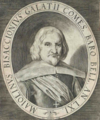
|
Majolino Bisaccioni Count of |
1632–1656 (24 years) |
Previously grand chancellor, appointed as vice-grand master (grand master vicar) by Giovanni Andrea I Angeli in 1632, retaining this position after Giovanni Andrea I Angeli's death two years later, despite the two having fallen out. Recognized Angelo Maria Angeli's succession but did not relinquish his power until 1656. | [11] |
| 42 | 
|
Angelo Maria Angeli Prince of Macedonia and Thessaly Duke and Count of Drivasto and Durazzo |
December 1634 – 1678 (44 years) |
Second cousin and designated successor of Giovanni Andrea I Angeli. Did not gain de facto control over the order until Majolino Bisaccioni relinquished his position in 1656. | [12] |
| 43 | Marco Angeli Prince of Macedonia and Thessaly Duke and Count of Drivasto and Durazzo |
1678–1679 (1 year) |
Brother of Angelo Maria Angeli. Counted in official lists, but the historicity of his tenure is uncertain as he may have died before his brother. | [12] | |
| 44 | Girolamo II Angeli Prince of Macedonia Duke and Count of Drivasto and Durazzo |
1679–1687 (8 years) |
Cousin and designated successor of Angelo Maria Angeli (or Marco Angeli) | [13] | |
| 45 | 
|
Giovanni Andrea II Angeli Prince of Macedonia Duke and Count of Drivasto and Durazzo |
1687 – 11 January 1698 (11 years) |
Brother of Girolamo II Angeli. Last male member of his family. | [14] |
House of Farnese (1698–1731)[]
| No. | Portrait | Name | Tenure | Succession and Notes | Ref |
|---|---|---|---|---|---|
| 46 | 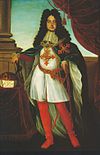
|
Francesco Farnese Duke of Parma and Piacenza |
11 January 1698 – 26 February 1727 (29 years, 1 month and 15 days) |
Purchased the position of grand master from Giovanni Andrea II Angeli. Documents of the sale specify that the order's hereditary succession from then on followed the descendants of Francesco Farnese. Further justified his claim to the order through matrilineal (female-line) descent from Isaac II Angelos. Rights confirmed by Pope Innocent XII and Holy Roman Emperor Leopold I. | [15] |
| 47 | 
|
Antonio Farnese Duke of Parma and Piacenza |
26 February 1727 – 20 January 1731 (3 years, 10 months and 25 days) |
Brother of Francesco Farnese. Last male member of his family. | [16] |
House of Bourbon-Two Sicilies (1732–present)[]
| No. | Portrait | Name | Tenure | Arms | Succession and Notes | Ref |
|---|---|---|---|---|---|---|
| 48 | 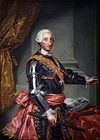
|
Charles III of Spain King of Spain King of Naples and Sicily Duke of Parma and Piacenza |
6 April 1732 – 16 October 1759 (27 years, 6 months and 10 days) |

|
Son of Elisabeth Farnese, niece of Francesco Farnese and Antonio Farnese. Legitimate senior heir of Antonio Farnese. Formally invested as grand master by a group of Constantinian knights on 6 April 1732. Confirmed as grand master by Pope Clement XII on 12 May 1739. | [17] |
| 49 | 
|
Ferdinand I of the Two Sicilies King of the Two Sicilies |
16 October 1759 – 4 January 1825 (65 years, 2 months and 19 days) |

|
Charles III became king of Spain in 1759, and due to agreements prohibiting the unification of the Spanish and Sicilian crowns, designated his third son Ferdinand as heir to his Italian possessions and as the new Constantinian grand master as "First Born Legitimate Farnese heir". Ferdinand's succession as grand master was confirmed by Pope Clement XIII on 18 December 1763. | [18] |
| 50 | 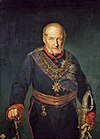
|
Francis I of the Two Sicilies King of the Two Sicilies |
4 January 1825 – 8 November 1830 (5 years, 10 months and 4 days) |

|
Son of Ferdinand I | [19] |
| 51 | 
|
Ferdinand II of the Two Sicilies King of the Two Sicilies |
8 November 1830 – 22 May 1859 (28 years, 6 months and 14 days) |

|
Son of Francis I | [19] |
| 52 | 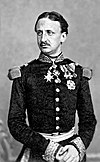
|
Francis II of the Two Sicilies King of the Two Sicilies |
22 May 1859 – 27 December 1894 (35 years, 7 months and 5 days) |

|
Son of Ferdinand II. Francis II was the last king of the Two Sicilies, being deposed in 1861 during the unification of Italy. Francis II retained his position as grand master after his deposition. | [20] |
| 53 | 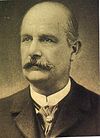
|
Prince Alfonso Count of Caserta |
27 December 1894 – 26 May 1934 (39 years, 4 months and 29 days) |

|
Brother of Francis II and heir to his claims and prerogatives | [21] |
| 54 | 
|
Prince Ferdinand Pius Duke of Castro Duke of Calabria |
26 May 1934 – 7 January 1960 (25 years, 7 months and 12 days) |

|
Son of Alfonso | [22] |
Disputed succession (1960–present)[]
The leadership of the Constantinian Order has been disputed since the death of Ferdinand Pius in 1960. The immediate male primogeniture heir of Ferdinand Pius was Infante Alfonso, the son of Pius' eldest younger brother Carlos.[23] Carlos married María de las Mercedes, Princess of Asturias, the heir presumptive of Spain, in 1901. As a result of the marriage, the Spanish government forced Carlos to renounce his "eventual succession to the crown" of the Two Sicilies, in line with the centuries-old agreement that the crowns of Spain and Two Sicilies were not to unify.[24] Although this renounciation was interpreted by many as removing Carlos and his descendants from the line of succession of the Two Sicilies, supporters of Alfonso argued that the renouciation would only have applied if Carlos' wife or an eventual son had actually become the sovereign of Spain, which did not happen. Nevertheless, Ferdinand Pius' and Carlos' younger brother, Ranieri, began to regard himself as Pius' heir.[24][25]
In Naples, the base of operations of the order, there was significant opposition towards the idea of Alfonso succeeding Pius as it was feared that he would introduce Spanish elements into what was otherwise viewed as a distinctly Neapolitan institution. Not only was Ranieri supported by many of the Constantinian Order's members, but Ferdinand Pius also made it clear that he wished Ranieri, and not Alfonso, to succeed him. Many of the order's knights felt obliged to respect Pius' wishes. At the same time as Ranieri was proclaimed grand master in Naples after Pius' death, Alfonso was proclaimed grand master in Madrid; Alfonso had at no point doubted his own rights and had not even been informed by his father that they had been "renounced" given that Carlos himself considered his supposed renounciation irrelevant.[26]
Whereas the claim of Ranieri and his descendants was supported by those in the senior ranks of the Constantinian Order,[27] as well as most royal houses in Europe, the claim of Alfonso and his descendants is supported by the Spanish Royal House.[25] Other supporters of Alfonso's claim included the exiled royals Robert of Parma (also grand master of his branch of the order) and Duarte Nuno de Bragança (head of the former royal house of Portugal). Noteworthy royal supporters of Ranieri's claim included Umberto II (the former king of Italy), Henri of Orléans (claimant to the throne of France), Archduke Gottfried of Austria (titular Grand Duke of Tuscany), Albrecht (titular Duke of Bavaria), Philipp Albrecht (titular Duke of Württemberg), Prince Amadeo (titular Duke of Aosta), Filiberto (titular Duke of Genoa) and Prince Michael of Greece and Denmark, among others.[28] Though the Italian government previously did not recognize the claims of Alfonso's descendants, and forbade the use of titles and honors granted by their order, in favor of recognizing Ranieri's line, since the 1980s, awards granted by both lines of grand masters have had the same legal recognition. The two sides of the family briefly reached the beginning stages of a resolution between 2014 and 2016, briefly recognizing the claimed noble titles of each other, before Prince Carlo (heir to Ranieri's claim) renounced his recognition of Prince Pedro's (the heir to Alfonso's claim) titles.[29]
|
Neapolitan branch (Ranieri's descendants)
|
Spanish branch (Alfonso's descendants)
|
Claimants and pretenders[]
Parmese Constantinian order (1816–present)[]
After the defeat of Napoleon, the Congress of Vienna accorded his former wife, Marie Louise of the House of Habsburg-Lorraine, the duchies of Parma, Piacenza and Guastalla, and shortly thereafter also Lucca (though she only held Lucca briefly), as the owner of those territories, the Kingdom of Etruria, had been a Napoleonic ally. Before she even reached her new territories, Maria Louise's advisor, companion and lover Adam Albert von Neipperg recognized that she would require the support of the local nobility in Parma in order to rule efficiently, and thus advised Marie Louise to found her own Constantinian Order, envisioned as a re-establishment of the original institution.[34]
Claiming that the grand mastership of the order was tied to the duchies of Parma and Piacenza and descent from the Farnese family, Marie Louise proclaimed herself grand master of the Constantinian Order on 26 February 1816. She was descended from the Farnese family through her grandfather, Ferdinand I of the Two Sicilies, who was still alive and still legitimately claimed the position of grand master himself. Although her claim to the position was immediately met with protest from Ferdinand, Maria Louise had the powerful support of her father, Emperor Francis I of Austria. Though Ferdinand protested to Pope Pius VII, there was little Pius could do other than refusing to recognize Maria Louise, especially in the face of Francis' support of her. Trying to reach a position of agreement, the official position of the court of the Two Sicilies was that Ferdinand's right to the order could not be diminished as it was based on primogeniture, but that Maria Louise was also in her right to found an order in imitation of the Constantinian Order given that she governed Parma; however due to the changes introduced by her, such as introductions of new classes, the order could not be considered a continuation of the ancient order. There was never any formal accord between Parma and Naples, but the two orders continued to maintain a status quo by refusing requests for awards by the other's subjects, and by the Parma order adding the adjectives "Imperial" and "Angelic" to the order's full name.[35]
House of Habsburg-Lorraine (1816–1847)[]
| No. | Portrait | Name | Tenure | Arms | Succession and Notes | Ref |
|---|---|---|---|---|---|---|
| (50) | 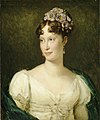
|
Marie Louise Duchess of Parma, Piacenza and Guastalla |
26 February 1816 – 17 December 1847 (31 years, 9 months and 21 days) |

|
Granddaughter of Ferdinand I of the Two Sicilies. Claimed the position (against Ferdinand I) by virtue of being a descendant of the Farnese family in possession of Parma. | [35] |
House of Bourbon-Parma (1848–present)[]
| No. | Portrait | Name | Tenure | Arms | Succession and Notes | Ref |
|---|---|---|---|---|---|---|
| (51) | 
|
Charles II Duke of Parma and Piacenza |
17 January 1848 – 17 May 1849 (1 year and 4 months) |

|
Succeeded Marie Louise as Duke of Parma per the Congress of Vienna. Assumed the position of grand master on 17 January 1848. | [36] |
| (52) | 
|
Charles III Duke of Parma and Piacenza |
8 October 1849 – 27 March 1854 (4 years, 5 months and 19 days) |

|
Son of Charles II, who abdicated in his favor in 1849. Formally took the position of grand master on 8 October 1849, after a period of exile. | [37] |
| (53) | 
|
Robert I Duke of Parma and Piacenza |
27 March 1854 – 16 November 1907 (53 years, 7 months and 20 days) |

|
Son of Charles III. Deposed as Duke after only four years, ending the Duchy of Parma. Robert thereafter lived in exile in Rome and then Vienna, continuing to claim the position of grand master. | [38] |
| (54) | 
|
Henry Duke of Parma and Piacenza |
16 November 1907 – 16 November 1939 (32 years) |

|
Son of Robert I | [39] |
| (55) | 
|
Joseph Duke of Parma and Piacenza |
16 November 1939 – 7 January 1950 (10 years, 1 month and 22 days) |

|
Son of Robert I | [39] |
| (56) | 
|
Elias Duke of Parma and Piacenza |
7 January 1950 – 27 June 1959 (9 years, 5 months and 20 days) |

|
Son of Robert I | [39] |
| (57) | 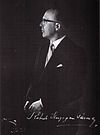
|
Robert Hugo Duke of Parma and Piacenza |
27 June 1959 – 15 November 1974 (15 years, 4 months and 19 days) |

|
Son of Elias | [39] |
| (58) | 
|
Prince Xavier Duke of Parma and Piacenza |
15 November 1974 – 7 May 1977 (2 years, 5 months and 22 days) |

|
Son of Robert I | [39] |
| (59) | 
|
Carlos Hugo Duke of Parma and Piacenza |
7 May 1977 – 18 August 2010 (33 years, 3 months and 11 days) |

|
Son of Xavier | [39] |
| (60) | 
|
Prince Carlos Duke of Parma and Piacenza |
18 August 2010 – present (11 years, 5 months and 22 days) |

|
Son of Carlos Hugo | [39] |
Other claimants[]
- Andrea Angeli (claimant 1634–1644), the youngest son of grand master Girolamo I Angeli. Disputed the succession of Angelo Maria Angeli in 1634 on account of Angelo Maria's father Michele Angeli having been born illegitimate.[40]
- Girolamo II Angeli (claimant 1644–1678/1679), the eldest son of Andrea. Girolamo II continued his father's lack of recognition of Angelo Maria as grand master. Upon the death of Angelo Maria in 1678 (or Marco in 1679), Girolamo II succeeded as the legitimate grand master of the order.[41]
- Ferdinand, Duke of Parma (claimant 1778–1802), a member of the House of Bourbon, Ferdinand claimed the position of grand master in opposition to Ferdinand I of the Two Sicilies on the erroneous argument that the office was tied to the Duchy of Parma (which Ferdinand held), rather than hereditary succession, similar to Marie Louis's later claim.[42]
Forgers[]

Because the position of grand master within the Constantinian Order is hereditary, numerous forgers and self-styled princes have claimed relations to either the Angeli family, or claimed entirely alternate lines of imperial descent (so as to produce a superior claim to the position). For the most part, such claimants can easily be dismissed as forgers and opportunists, typically without genuine links to Greek or Albanian families.[43] Many later pretenders have purported to be either part of the order, or its legitimate grand master.[44]
- John George Heracleus Basilicos (claimant c. 1566–1593), a claimant to Byzantine heritage just like the Angeli family, John George and Andrea Angeli (grand master c. 1545–1580) recognized each other as Byzantine descendants and relatives out of mutual benefit. In the 1560s, John George proclaimed himself grand master, a claim he maintained until he was imprisoned in 1593 after the papacy favored the claims of grand master Giovanni Andrea I Angeli over his.[45][43]
- Gian Antonio Lazier (claimant c. 1720–1738), forged relations with the Angeli family and the Palaiologos dynasty of Byzantine emperors and thus challenged Francesco Farnese's assumption of the position of grand master, arguing that his line of Byzantine descent was superior to that of Farnese and that the sale of the position was of questionable legality.[46][47] Seen by some contemporaries as having an equally valid claim to the position as Farnese,[48] Lazier was officially supported by Charles VI, Holy Roman Emperor, until around the time his forgeries were exposed by Farnese in 1725.[49]
- Radu Cantacuzino (claimant c. 1735–1761), descendant of the Byzantine Kantakouzenos family and son of Ștefan Cantacuzino, Prince of Wallachia (r. 1714–1716).[50] Inventing a line of descent directly from Emperor John VI Kantakouzenos, Cantacuzino claimed the grand mastership as a rival to both Francesco Farnese and Gian Antonio Lazier, perhaps with recognition from Charles VI, Holy Roman Emperor.[51][52]
- Ioannis Rhodocanakis (claimant c. 1860–1895), father of Demetrius Rhodocanakis, proclaimed as the legitimate grand master in the writings of his son.[53]
- Demetrius Rhodocanakis (claimant 1895–1902), forged descent from the Palaiologos dynasty of Byzantine emperors, claiming female-line descent from Theodore Paleologus (c. 1560–1636).[54] Claimed the position of grand master and the title of emperor after his father's death in 1895.[55] In 1871, Rhodocanakis' claims were recognized by the papacy after an audience with Pope Pius IX.[55][44] His claims had been thoroughly exposed and debunked by the early 20th century.[56]
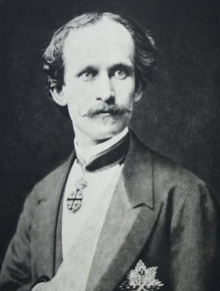 Demetrius Rhodocanakis, who claimed to be the legitimate grand master in the late 19th and early 20th century through forged connections to the Palaiologos dynasty
Demetrius Rhodocanakis, who claimed to be the legitimate grand master in the late 19th and early 20th century through forged connections to the Palaiologos dynasty - Eugenio Lascorz (claimant c. 1906–1962), forged descent from the Laskaris dynasty of Byzantine emperors, claiming the position of titular emperor as well as claiming to be the rightful grand master of the Constantinian Order, as well as of a self-styled order, the "Order of Saint Eugene of Trebizond".[57]
- Paul Crivez (claimant 1945–1984), claimed to be the rightful senior heir of the Palaiologos dynasty through adoption by Alexandrine Paléologue (born Boutcoulesco), the widow of a man named Grégoire Paléologue. Crivez forged a genealogy that made Grégoire out to be a descendant of Manuel Palaiologos.[58]
- Marziano Lavarello (claimant c. 1948–1992), forged descent from the Laskaris and Palaiologos dynasties, claiming to be the rightful emperor as well as the rightful grand master of the Constantinian Order. Lavarello's claims were recognized by a court in Rome in 1948.[59]
- Peter Mills (claimant 1960s–1988), forged descent from the Palaiologos dynasty, through Manuel Palaiologos, claiming to be the rightful emperor as well as the rightful grand master of the Constantinian Order.[60]
- Enrico de Vigo Paleologo (claimant 1961–2010), forged connections to the Laskaris and Palaiologos dynasty, and even as far back as Emperor Nero (r. 54–68). Claimed to be the rightful emperor and grand master of both the Constantinian Order and his own "Order of the Cross of Constantinople".[61]
- Teodoro Láscaris (claimant 1962–2006), son and heir of Eugenio Lascorz.[57]
- Pietro Paleologo Mastrogiovanni (claimant 1966–2017), forged descent from Thomas Palaiologos, claimed to be the rightful emperor and grand master.[62]
- Patricia Palaeologina (claimant 1988–present), widow of Peter Mills and continuator of his claims, his children by his first wife having renounced his pretensions as a "utter sham".[63]
- Arcadia Luigi Maria Picco (claimant 1992–present), questionably claims to have been willed the claims and titles of Marziano Lavarello, presenting himself as Lavarello's successor as titular emperor and grand master of the Constantinian Order.[64]
- Eugenio Láscaris (claimant 2006–present), son and heir of Teodoro Láscaris.[57]
- Françoise Paleologo (claimant 2010–present), widow and designated heir to the position of grand master of Enrico Constantino de Vigo Aleramico Lascaris Paleologo.[65]
- Giovanni Angelo Paleologo Mastrogiovanni (claimant 2017–present), son and heir of Pietro Paleologo Mastriogiovanni.[66]
See also[]
References[]
- ^ Sainty 2018, p. 41.
- ^ Sainty 2018, p. 42.
- ^ Nicol 1992, p. 121.
- ^ Sainty 2019, pp. 409–411.
- ^ Sainty 2018, pp. 409–411.
- ^ Sainty 2018, pp. 58, 410.
- ^ Sainty 2018, pp. 76, 410.
- ^ a b Sainty 2018, pp. 73, 410.
- ^ Sainty 2018, pp. 89–90, 410.
- ^ Sainty 2018, pp. 90, 410.
- ^ Sainty 2018, pp. 87, 94, 104, 208, 411.
- ^ a b Sainty 2018, pp. 93–95, 411.
- ^ Sainty 2018, pp. 98, 106, 411.
- ^ Sainty 2018, pp. 98, 127, 411.
- ^ Sainty 2018, pp. 12, 127–129, 411.
- ^ Sainty 2018, pp. 163–164, 411.
- ^ Sainty 2018, pp. 163–164, 167, 172, 411.
- ^ Sainty 2018, pp. 183–186, 411.
- ^ a b Sainty 2018, pp. 203, 411.
- ^ Sainty 2018, pp. 245, 249, 265, 411.
- ^ Sainty 2018, pp. 279, 411.
- ^ Sainty 2018, pp. 339, 340, 343, 411.
- ^ Sainty 2018, p. 347.
- ^ a b Sainty 2018, p. 288.
- ^ a b Opfell 2001, pp. 37–38.
- ^ a b Sainty 2018, pp. 347–350.
- ^ Sainty 2018, p. 349.
- ^ Sainty 2018, pp. 359–360.
- ^ Sainty 2018, pp. 392, 399.
- ^ a b c Constantinian Order.
- ^ Sainty 2018, pp. 347–350, 411.
- ^ Sainty 2018, pp. 371, 411.
- ^ Sainty 2018, pp. 389, 411.
- ^ Sainty 2018, p. 225.
- ^ a b Sainty 2018, pp. 225–229.
- ^ Sainty 2018, p. 229.
- ^ Sainty 2018, pp. 229–230.
- ^ Sainty 2018, p. 230.
- ^ a b c d e f g borboneparma.it.
- ^ Sainty 2018, pp. 82, 417.
- ^ Sainty 2018, pp. 82, 106.
- ^ Sainty 2018, pp. 175–177.
- ^ a b Sainty 2018, p. 73.
- ^ a b Nicol 1992, p. 120.
- ^ Hassiotis 1982–1983, p. 86, 89, 91, 93–95.
- ^ Sainty 2018, p. 146.
- ^ Olar 2014, p. 130.
- ^ Kolditz 2012, p. 192.
- ^ Olar 2013, p. 138.
- ^ Chindriș & Iacob 2015, pp. 10–11.
- ^ Gastgeber 2018, p. 366.
- ^ Chindriș & Iacob 2015, p. 16.
- ^ Rhodocanakis 1870, p. 30.
- ^ Hall 2015, p. 52.
- ^ a b Jahn 2016, p. 9.
- ^ Hall 2015, p. 53.
- ^ a b c new-byzantium.org.
- ^ Cheesman & Williams 2000, p. 126.
- ^ Campagnano 2001, p. 3.
- ^ Nicol 1992, p. 125.
- ^ Hall 2015, p. 223.
- ^ "Fondazione Imperiale Bisanzio: SAIR il Principe Giovanni Paleologo di Bisanzio". Fondazione Imperiale Bisanzio. 29 December 2019. Retrieved 2021-10-12.
{{cite web}}: CS1 maint: url-status (link) - ^ Nicol 1992, p. 127.
- ^ Adelsrecht.
- ^ byzantine.ws.
- ^ "Fondazione Imperiale Bisanzio: SAIR il Principe Giovanni Paleologo di Bisanzio". Fondazione Imperiale Bisanzio. 29 December 2019. Retrieved 2021-10-12.
{{cite web}}: CS1 maint: url-status (link)
Bibliography[]
- Campagnano, Anna Rosa (June 2001). "O "Conde" Raphael Mayer, um benfeitor quase esquecido". Gerações/Brasil: Boletim da Sociedade Genealógica Judaica do Brasil. Vol. 10.
- Cheesman, Clive; Williams, Jonathan (2000). Rebels, Pretenders and Imposters. New York: St. Martin's Press. ISBN 978-0312238667.
- Chindriș, Ioan; Iacob, Niculina (2015). O diplomă privilegială inedită a episcopului Inochentie Micu-Klein [An unprecedented privileged diploma of Bishop Inochentie Micu-Klein] (PDF) (in Romanian). Bucharest: National Library of Romania. ISBN 978-6066903264.
- Gastgeber, Christian (2018). "Wien und das neu begründete imperium Romano-Byzantinum (1720-1738). Der selbst ernannte Großmeister des Konstantinischen Ritterordens des Heiligen GeorgIohannes IX. Antonius I. Flavius, Angelus, Comnenus, (Ducas), Lascaris, Paleologus" [Vienna and the re-founded imperium Romano-Byzantium (1720-1738). The self-proclaimed grand master of the Constantinian Order of knights of Saint George Iohannes IX Antonius I Flavius, Angelus, Comnenus, (Ducas), Lascaris, Paleologus]. In Daim, Falko; Gastgeber, Christian; Heher, Dominik; Rapp, Claudia (eds.). Menschen, Bilder, Sprache, Dinge: Wege der Kommunikation zwischen Byzanz und dem Westen 2: Menschen und Worte. Mainz: Verlag des Römisch-Germanischen Zentralmuseums. ISBN 978-3795433161.
- Hall, John (2015). An Elizabethan Assassin: Theodore Paleologus: Seducer, Spy and Killer. Stroud: The History Press. ISBN 978-0750962612.
- Hassiotis, Ioannis (1982–1983). "George Heracleus Basilicos, a Greek Pretender to a Balkan Principality (End of the XVI – Beginning of the XVII century)" (PDF). Balcanica (XIII–XIV): 85–96. ISSN 0350-7653.
- Jahn, Regina (2016). Die Bibliothek des Demetrios Rhodokanakis: Untersuchungen im Zusammenhang mit dem Auktionskatalog der Büchersammlung (Rom 1904) (PDF) (Master's thesis). Universität Wien.
- Kolditz, Sebastian (2012). "Nur Decline and Fall? Zum Bild der späten Palaiologenherrschaft in Schriften des achtzehnten Jahrhunderts" [Only Decline and Fall? On the image of the late Palaiologan rule in writings of the eighteenth century]. In Kolovou, Foteini (ed.). Byzanzrezeption in Europa: Spurensuche über das Mittelalter und die Renaissance bis in die Gegenwart. Berlin: Walter de Gruyter. ISBN 978-3110272062.
- Nicol, Donald M. (1992). The Immortal Emperor: The Life and Legend of Constantine Palaiologos, Last Emperor of the Romans. Cambridge: Cambridge University Press. ISBN 978-0-511-58369-8.
- Olar, Ovidiu (2014). "Intrigi politice, strategii de ascensiune socială și genealogii fabuloase. Episcopul Inochentie Micu, Cavaler și Prefect Suprem pentru Dacia al Ordinului "Constantinian" al Sf. Gheorghe" [Political Intrigues, Strategies to Achieving a Higher Social Status and Fabulous Genealogies. Bishop Inochentie Micu, Knight and Supreme Prefect for Dacia of the "Constantinian" Order of St. George]. Apulum (in Romanian). 51 (2): 129–161. ISSN 1013-428X.
- Opfell, Olga S. (2001). Royalty Who Wait: The 21 Heads of Formerly Regnant Houses of Europe. McFarland & Company. ISBN 978-0786409013.
- Rhodocanakis, Demetrius (1870). The Imperial Constantinian Order of St. George: A Review of Modern Impostures and a Sketch of Its True History. Longmans, Green, and Co.
- Sainty, Guy Stair (2018). The Constantinian Order of Saint George: and the Angeli, Farnese and Bourbon families which governed it. Boletín Oficial del Estado. ISBN 978-8434025066.
Web sources[]
- Familienverband der Freiherren von Quast. "Marziano Lavarello – Nobiliary law – Adelsrecht – Droit nobiliaire". Nobiliary law - Adelsrecht - Droit nobiliaire (in Dutch). Retrieved 2021-09-18.
{{cite web}}: CS1 maint: url-status (link) - "Legal Documents". The Constantinian Order of St. George. Retrieved 6 October 2021.
{{cite web}}: CS1 maint: url-status (link) - "The Grand Magistry of the Bourbon Two Sicilies". Sacred Military Constantinian Order of Saint George. Retrieved 6 October 2021.
{{cite web}}: CS1 maint: url-status (link) - "The Great Seal of the Lascaris Comnenus". www.new-byzantium.org. Retrieved 2020-03-02.
{{cite web}}: CS1 maint: url-status (link) - "Ordine Costantiniano di San Giorgio". www.borboneparma.it. Retrieved 2021-10-06.
- Lists of Grand Masters
- Lists of Roman Catholics






